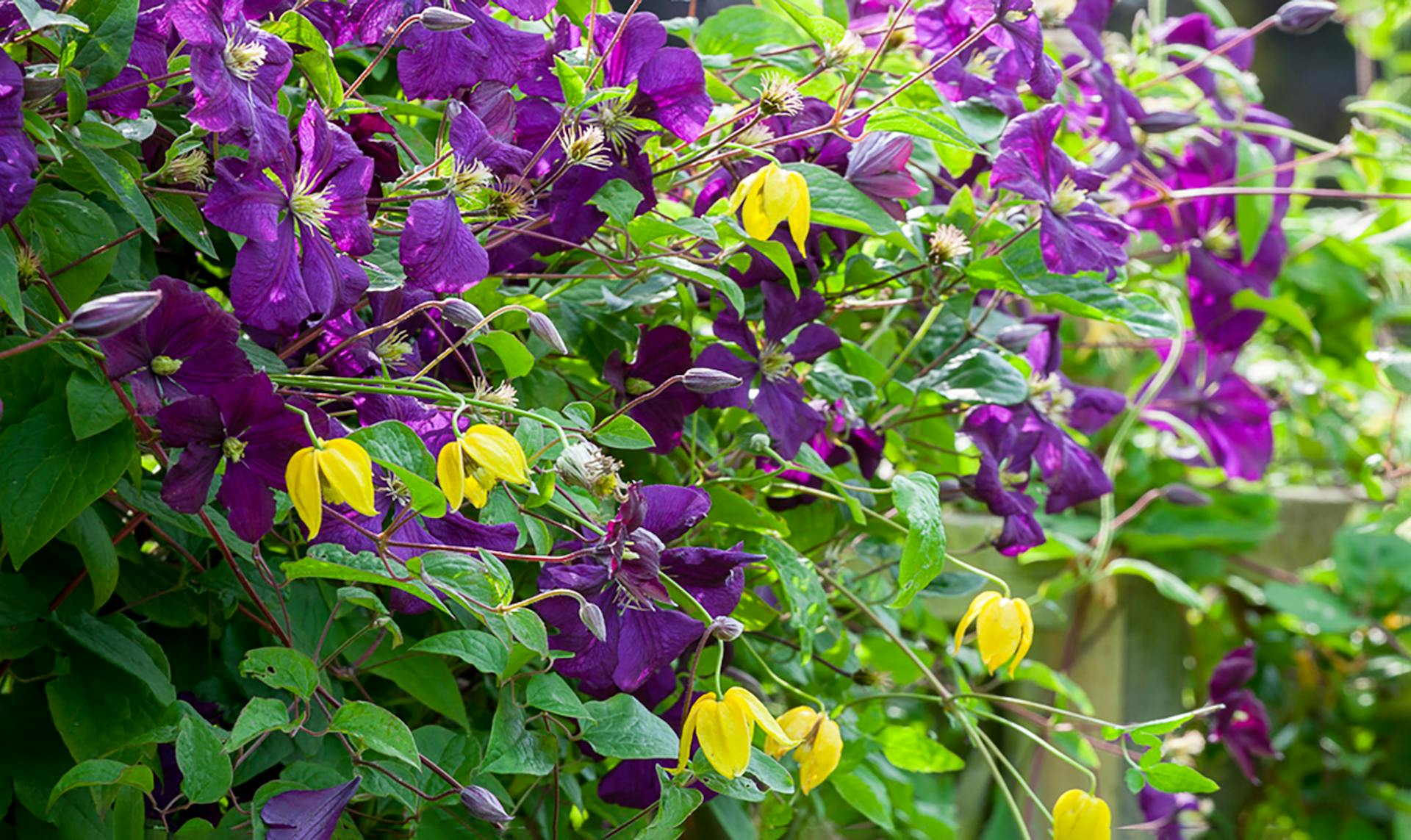how to plant, grow & care for clematis
complete growing guide
Cascading down over arches, scrambling through trees or up a garden wall, climbers add another dimension to gardens. The breadth of choice is thrilling – with a bit of planning, you could have a clematis in flower every month of the year.
There are clematis flowers that are huge and starry, and ones that are elegant and fluted, there are singles and semi-doubles, and ones that look like passion flowers. Some grow in a mound and trail prettily filling borders or pots, others train up into trees to tumble down from above your head. They can have beautiful, dramatic seedheads and incredible scent that fills the garden. We have a selection of clematis plants that covers them all.
details
- Common name: Clematis
- Latin name: Clematis
- Type: Deciduous/Evergreen Climber/Herbaceous
- Height: 60cm (2ft) to 9m (30ft)
- Spread: Around 1m (3ft), or more if stems are fanned out
- TLC rating: Easy
- Aspect: Full Sun or Part Shade
- Planting position: Back of borders, Containers
- Suitable for pots: Yes
- Good for pollinators: Yes
- Good for cut flowers: Yes
how to grow clematis

where to grow clematis
Soil type: Clematis prefer moist, well-drained soil with the base of the plant in shade and growth tips in light.
Aspect & position: Depending on the clematis, it might need full sun or part shade, but they will all need protection at the base from heat and light as clematis roots need to be cool.
Clematis will require support on a wall or in the border over which it can climb.
when to plant clematis
Clematis can be planted out at any time in the year as long as the ground isn’t frozen or waterlogged.
how to plant clematis
Choose a position in full sun or part shade depending on the clematis and make sure there is good support, such as a wall, fence, pergola or tree for the clematis to scramble up or over.
When planting next to a wall or fence, dig the hole at least 45cm (1½ft) from the wall and train the plant along the cane towards the wall.
When planting next to shrubs or trees, place the hole outside the rain shadow about 60-90cm (2-3ft) from the trunk, and use the canes to train the plant into the shrub/tree.
Dig the hole at least twice as wide as the pot in which the plant is growing and half as deep again. Add plenty of organic matter (such as leaf-mould) to the bottom of the hole.
Soak the plant well before carefully removing the plant with its cane support from the container. Gently tease out some of the roots and place in the hole.
Large flowered cultivars should be planted with the top of the root ball 7cm (3in) below soil level. Planting this deep will encourage the plant to become multi-stemmed. Species clematis, which have thin fibrous root systems, do not need to be planted deeply.
Back-fill with a mixture of soil and compost. Water regularly until well established.
Keep the base of the plant and the roots cool and shaded by carefully positioning other shallow-rooted plants, or put a layer of pebbles or mulch at the base – don’t apply the mulch right up to the stem. And don’t use large pieces of slate or terracotta as these provide ideal hiding places for snails. Mulch will offer protection from heat and light and help retain moisture.
Put some slug/snail prevention in place to prevent damage to young shoots.

growing clematis in a pot
To grow clematis in pots it’s best to use a large container – at least 45cm (1½ft) in diameter with the same depth. This will allow space for good root growth.
Make sure a suitable support is in place such as an obelisk, or place the pot by a wall or fence with a small trellis. Use a loam-based compost to fill your container, such as John Innes No. 3.
Keep the base of the plant and the roots cool and shaded by top dressing with a layer of pebbles. You can also mulch around the base to offer protection from heat and light.
Water regularly and feed throughout the growing season to maintain healthy growth and lots of flowers! But hold off fertilising while flowering as this can shorten the flowering period.
how to care for clematis
watering
Newly planted clematis will need regular watering whilst they establish. All clematis will need watering during hot, dry periods. A thorough, deep soaking once a week is better than watering little and often.
fertilising
Feed your clematis each year in late winter or early spring, but hold off fertilising while flowering as this can shorten the flowering period. Spread a slow-release, potassium-rich fertiliser around the base of the plant and apply a mulch of organic matter such leaf mould or compost.
staking
Clematis are among the showiest of climbers and they need a support to scramble over, so consider where it will be positioned carefully. You can transform a pergola or wall, or be more adventurous and plant one through a tree.
Tie plants in strongly to the frame, as they will – at full tilt – carry a lot of weight.
The late-summer-flowering, viticella-type clematis (usually group 3) need training and guiding up and over shrubs and climbing roses to maximise their impact. Without this they tend to make a congested nest. Spread the stems out on their support or frame, tying them in with gentle flexi-tie or sweet pea twizzles as you go.
deadheading
Deadheading some clematis will encourage further flowering, but some offer just a single-flush of flower.
propagating
Clematis can be propagated by cuttings, layering and seed sowing.

how to prune clematis
Clematis are divided into three groups or categories for pruning purposes: winter and spring-flowering, early-summer-flowering, and late-summer and autumn-flowering. A lot of people worry about pruning their clematis, but it is very simple if you follow these guidelines.
Pruning Group 1 Clematis
(early spring, e.g. Alpina, Montana, Armandii)
The clematis in group 1 are mostly the early spring varieties that flower on the previous year's growth. Little or no pruning is needed, unless they have outgrown their allocated space, in which case they should be pruned immediately after flowering.
Every few years they may need a tidy when they finish flowering. Don't leave this too late or you'll lose next year's flowers – June/July is the perfect time. Trim back to a permanent framework of branches. Always hold your pruners vertically to avoid cutting into a central vine.
Pruning Group 2 Clematis
(late spring, e.g. Nelly Moser)
The clematis in group 2 produce their flowers in May and early June on stems grown the previous year. These need to be pruned lightly in February. To do this, follow your way down from the top of each stem until you reach a healthy bud and then cut on a slant just above it and remove old, dead stems above it. Do not prune too vigorously or you will lose the flowers. Prune again after flowering if required to tidy up the shape, if not leave for a second flush of flowers.
Pruning Group 3 Clematis
(late summer, e.g. Prince Charles, Madame Julia Correvon & Texensis)
The clematis in group 3 produce their flowers on the new season’s growth in summer and autumn. These need hard pruning in February. Cut all stems (just above a healthy new bud) approximately 30cm (1ft) from the ground. Remove all dead growth above this. It sounds drastic, but they will grow and flower in one season.
If you are unsure or forget which group your Clematis fall into, the simple way to remember is that if they flower before June, prune lightly as they will flower on the previous year's growth. If they flower from late June onwards, hard prune in February as they will flower on new season’s growth.
seasonal checklist
spring
- Plant clematis in pots and in the garden.
summer
- Lightly prune clematis in group 1.
autumn
- Plant clematis in pots and in the garden.
winter
- Prune clematis in group 2 or 3.
pests, diseases & common issues
powdery mildew
Powdery mildew can affect clematis. It’s a fungal disease that shows up as a powdery coating on the foliage. You can remove any affected leaves and try an organic solution such as homemade comfrey tonic to keep mildew at bay.
The best way to avoid powdery mildew is to ensure clematis is properly pruned and watered regularly, but don’t allow the soil to get waterlogged or soggy.
clematis wilt
Clematis wilt is a fungal disease that tends to affect large-flowered clematis rather than the small-flowered types. Symptoms include wilting of leaves starting from the top of the plant and black stalks. If you think the plant has clematis wilt, cut off affected parts and dispose of them (but not in the compost heap). Cut back to 30cm (1ft) above the ground if necessary. As the clematis has been planted deeply it should throw up new shoots from below ground level.
It’s important to eliminate other potential causes for wilting leaves. Clematis roots need to be kept cool and shaded and the plant needs to be in fertile soil – so make sure the plant isn’t experiencing any stress before diagnosing clematis wilt.
clematis slime flux
You’ll know if your plant has clematis slime flux as you’ll see and smell a slime oozing from the stem and running down it. You might also notice yellowing leaves and a general lack of vigour. It’s a bacterial issue that’s not hugely common, but if you do notice it, cut out any affected stems.
clematis green petal
Clematis can suffer what’s known as clematis green petal, a pretty harmless disorder that results in flowers opening with green colouring in the petals. It tends to show up more prominently on pale-flowered clematis and could be brought on by cold weather. If you have a repeat-flowering clematis, the second flush is unlikely to be affected.

why is my clematis not flowering?
Even though the roots of a clematis need to be kept shaded and cool, the top of the plant needs full sun or part shade to flower properly – clematis may fail to flower in a very shady spot. You also need to prune clematis each year to encourage flowering.
why is my clematis dying from the bottom up?
The roots of the clematis need to be kept cool and have access to nutrients. To keep them shaded, put a layer of pebbles at the base or add a thick mulch of organic matter to offer protection from heat and light and help retain moisture – don’t apply the mulch right up to the stem.
why is my clematis wilting?
This could be clematis wilt, however it could also be an indication the plant is under stress. Check that the roots are shaded by placing a layer of pebbles or mulch. Avoid waterlogged soil. And make sure the plant is protected from slugs and snails that might weaken the plant from the bottom.
why are my clematis leaves turning yellow?
This could be a lack of nutrients and a sign the plant needs to be fed. Alternatively, it could be one of the ailments listed here, such as clematis wilt.
frequently asked questions
what kind of clematis do I have?
Clematis fall into three pruning groups – you can usually determine which group your clematis is in by noting when it flowers and if it flowers more than once. Group 1 are winter- and spring-flowering clematis, group 2 are repeat-flowering clematis that flower in spring and summer, and group 3 are summer- or autumn-flowering clematis.
how fast does clematis grow?
Some clematis grow quickly – a clematis in group 3 can grow several metres in one growing season before being pruned back.
can clematis grow in shade?
Most clematis prefer full sun or part shade – a clematis in shade will struggle to flower.
is clematis poisonous to dogs?
Yes, clematis is toxic to dogs and cats.
which clematis are evergreen?
Clematis armandii and Clematis cirrhosa are evergreen options. You can find a clematis for every month of the year.
can clematis be rooted in water?
It is possible to propagate clematis from cuttings placed in water.
will clematis kill a tree?
Some types of clematis are suited to climbing up and through shrubs and trees. If maintained and pruned properly, even the most vigorous shouldn’t get out of hand or cause harm to the tree.
will clematis grow up a wall or on a fence?
Yes, clematis are among the showiest of climbers and need a wall, fence or structure of some sort to grow up or over.
do clematis attract bees?
Bees and other pollinators are attracted to clematis.
can clematis be moved or transplanted?
Yes, you can transplant a clematis, but they have deep roots, so be prepared to dig a wide and very deep hole in order to minimise root damage. You’d need to attempt it after pruning, when the clematis is cut back low to the ground.
how to cut & arrange clematis

Cut clematis early in the morning or evening. Select only the blooms in good condition growing on strong and healthy stems. And use flowers which are not fully open, as they will unfurl their sepals (tepals) gradually after cutting and placing them in water, which will give you a longer display.
I love them trailing out of the side of a tall, slim bottle, a single stem to each on their own, as well as cascading down the side of an urn in a mixed arrangement. And then of course, we use the seedpods a lot in autumn vases and Christmas wreaths. You can forage wild clematis (C. vitalba) and help them keep their fluff on by standing their stem ends in a diluted glycerin solution, or simply spray them with cheap supermarket hairspray (or a more expensive fixative from an art shop).
Get more inspiration for displaying your flowers with our flower arranging videos:










